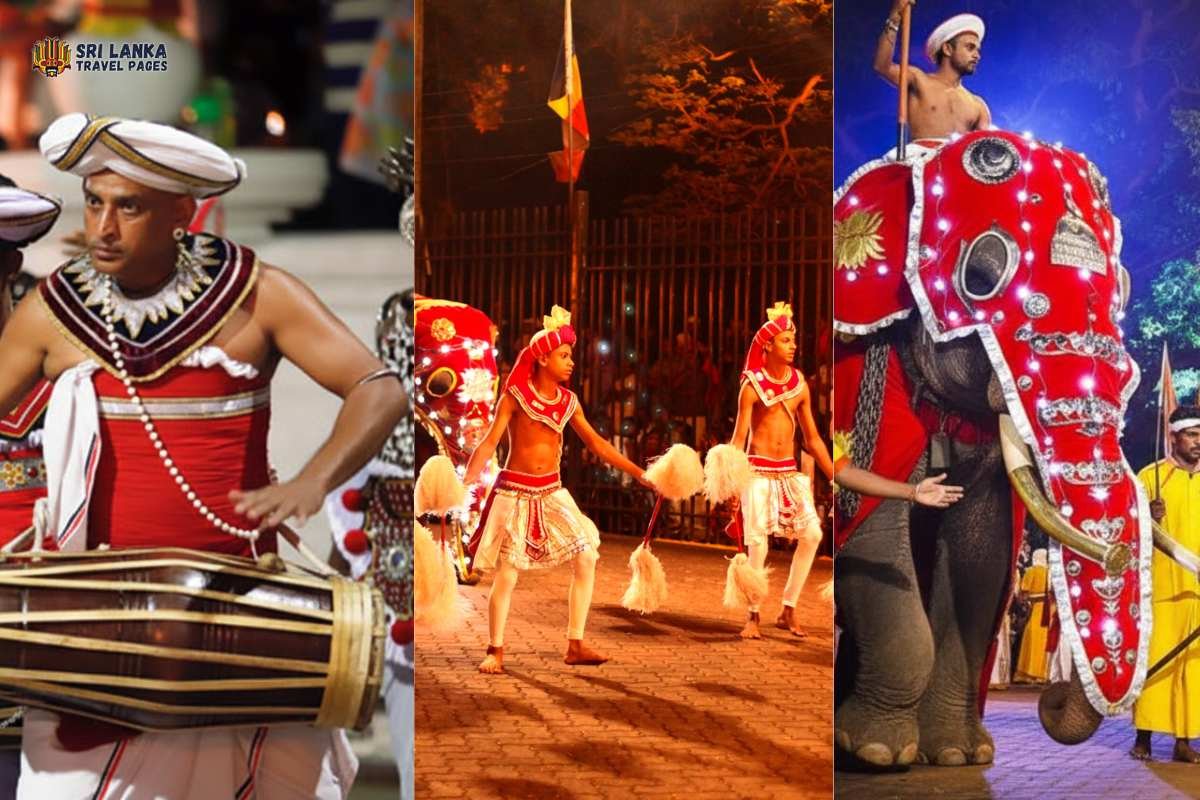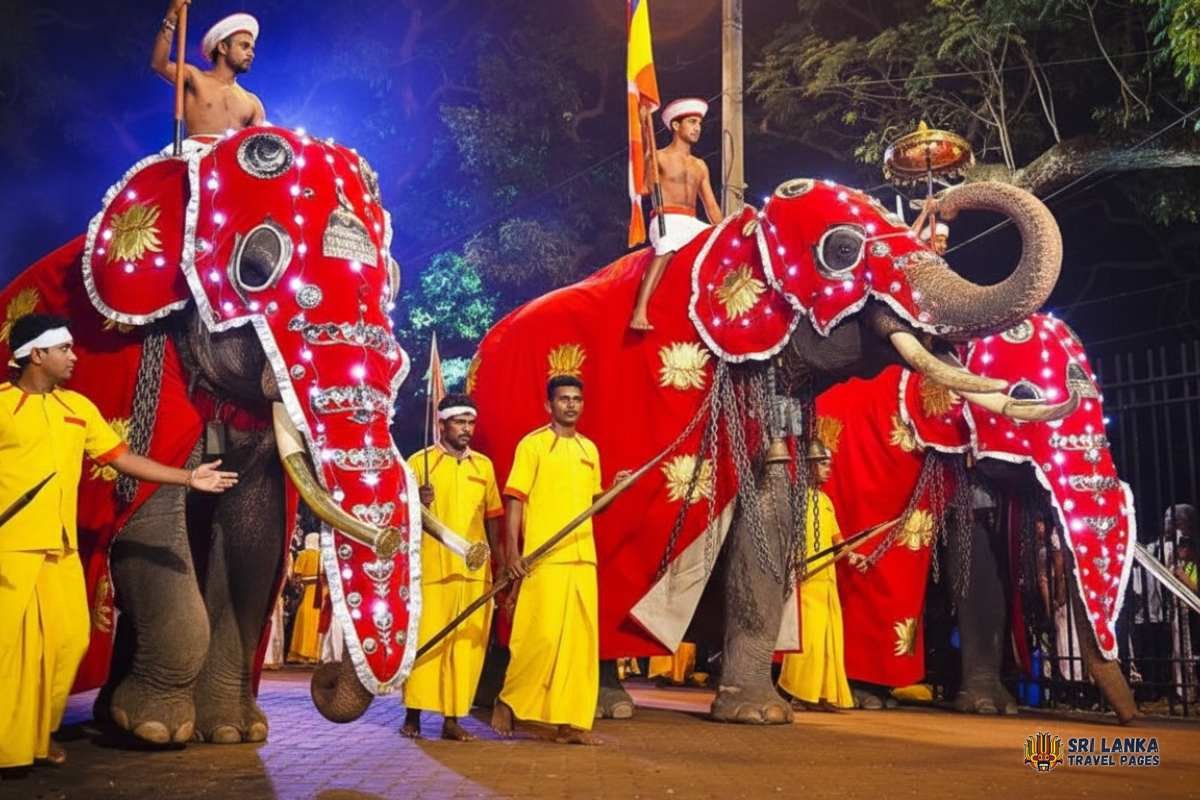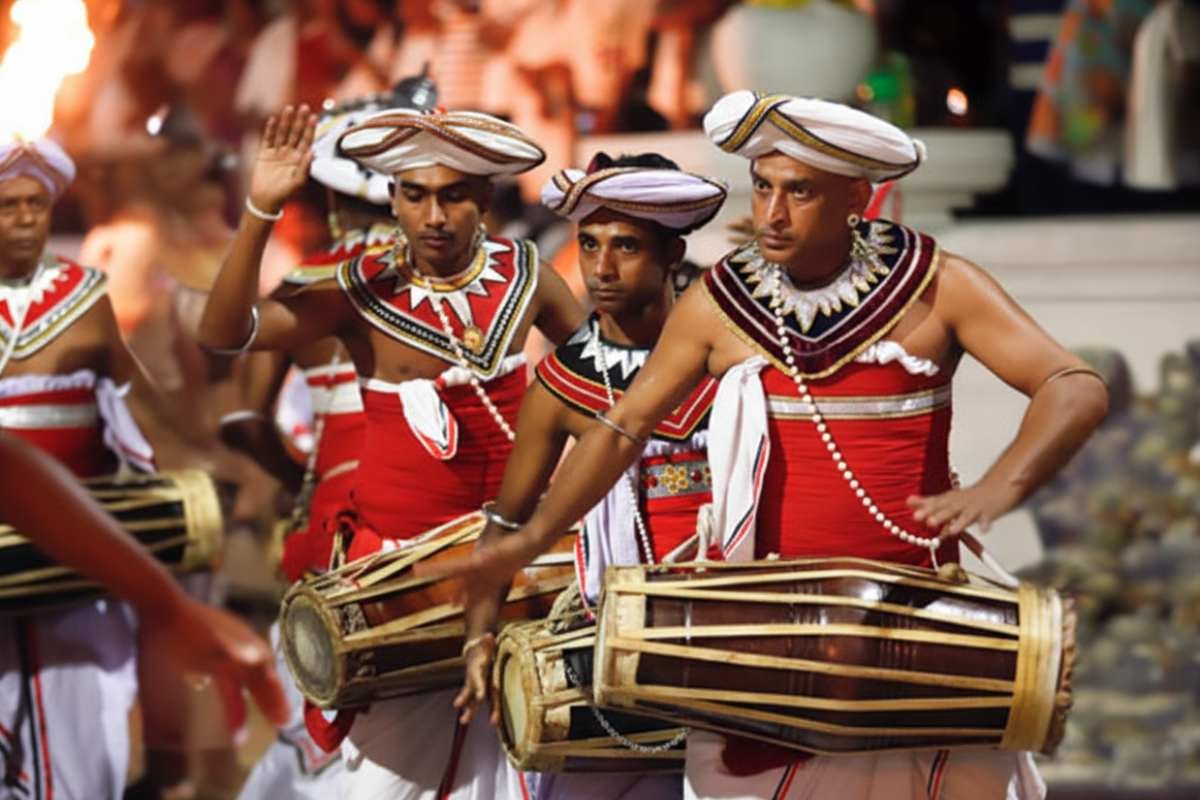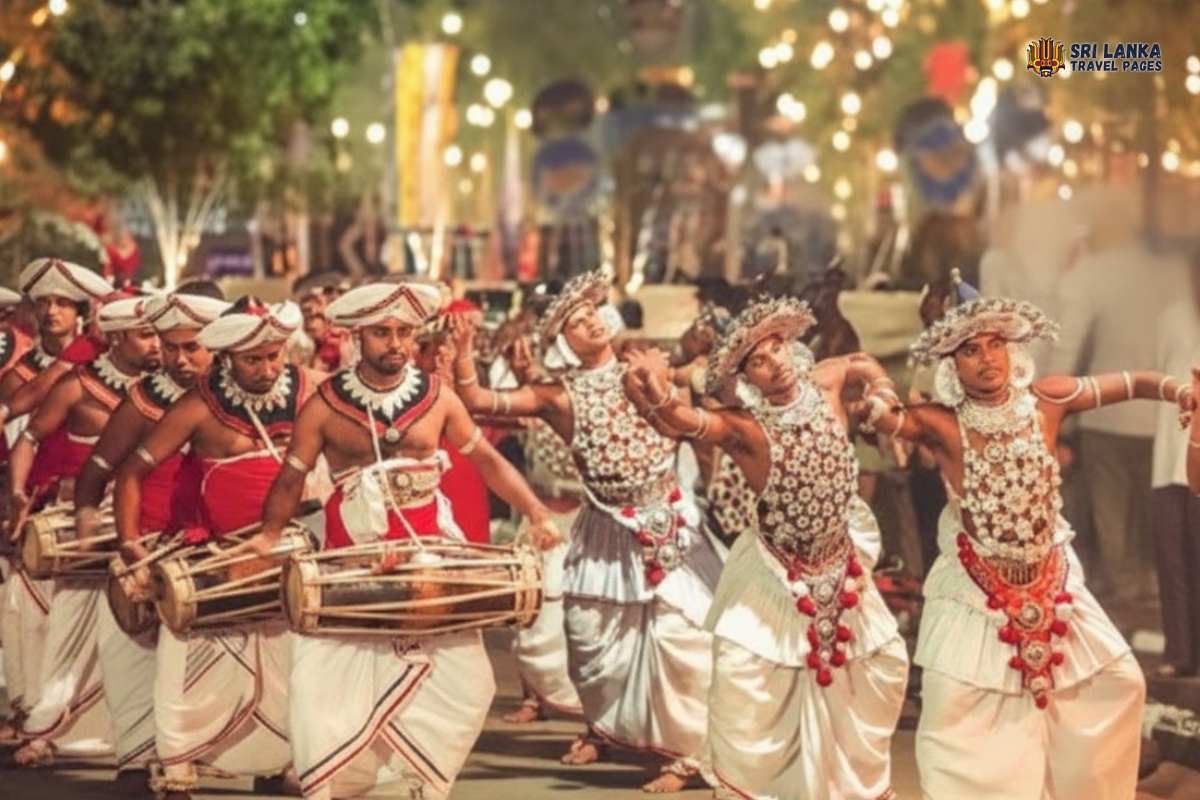
2026 Kelaniya Perahera Dates: Udamaluwa Perahera – · Pahatha Maluwa Perahera – · Randoli (Maha Perahera) –
Two richly adorned elephants carry the sacred relic casket, illuminated in the night during the Kelaniya Duruthu Perahera. The Kelaniya Duruthu Perahera is one of Sri Lanka’s most revered cultural and religious events, held annually in January at the historic Kelaniya Raja Maha Viharaya temple, about 10 km northeast of Colombo. This grand procession commemorates Lord Buddha’s legendary first visit to the island and showcases over 2,500 years of Buddhist heritage. Revived in 1927 after a long hiatus, the festival has since grown into a spectacular pageant that draws thousands of devotees and tourists from around the world. The perahera (procession) unfolds in a mesmerising display of devotion and artistry – so extensive that the entire parade can take over two hours to pass a given point. It is a living testament to faith and heritage, blending deep religious significance with Sri Lanka’s finest traditional performances.
Historical and Religious Significance

Kelaniya Raja Maha Viharaya is an ancient Buddhist temple believed to date back over two millennia. According to Sri Lankan chronicles, the site is hallowed by the Buddha’s visit during the month of Duruthu (January) in the ninth month after his Enlightenment. Tradition holds that the Buddha accepted an invitation from the Naga King Maniakkikha and preached at Kelaniya, seated on a gem-studded throne (Mandapaya) which is now believed to be enshrined within the temple’s dagoba (stupa). The annual Duruthu Perahera was established to commemorate this sacred visit and honour the start of Buddhism in Sri Lanka.
Historically, the Kelaniya temple flourished under royal patronage, but the Perahera tradition itself was rekindled in the early 20th century. The modern Duruthu Perahera was first organised in 1927 under the guidance of philanthropist Helena Wijewardene and her son Don Walter Wijewardene. In its inaugural form, it consisted of just two sections – the Dhātu (Relic) Perahera carrying the sacred Buddha relics, and the Vibhīshana Devale Perahera venerating God Vibhishana (a guardian deity of Kelaniya). Over subsequent years, two more deity processions were added – one for God Vishnu (patron deity of Sri Lanka) and one for God Skanda Kataragama (the warrior deity). Today, the Duruthu Perahera pageant is composed of multiple processions: the main temple procession bearing the relic casket, followed by the processions of the three devales (shrines) dedicated to Vishnu, Kataragama, and Vibhishana. This structure symbolises the integration of Buddhist worship with the veneration of protective deities.
Equally important are the preceding religious observances. The Perahera is the climax of a month-long festival of worship at Kelaniya, which typically starts in December with temple sermons and a week of continuous pirith chanting (protective recitations). These ceremonies build spiritual momentum leading up to Duruthu Full Moon Poya day (the January full moon), when the grand processions take place. The result is a deeply spiritual atmosphere: the festival is not merely a tourist spectacle, but a devotional pilgrimage for thousands of Buddhists. Many believe participating or witnessing the Perahera brings blessings for the new year, as Duruthu is the first full moon of the year and marks an auspicious beginning.
Three Nights of Pageantry: Duruthu Perahera 2026 Schedule

Udamaluwa Perahera
Modest inaugural ceremony within the upper courtyard; cannon signals the start. The Dhātu (Relic) Perahera alone proceeds on a smaller scale with a limited ensemble of performers and elephants.
Pahatha Maluwa Perahera
Full procession moves to the streets: Dhātu Perahera followed by the Vishnu, Kataragama, and Vibhishana Devale peraheras. More elephants, drummers, dancers, and dignitaries in full regalia.
Randoli (Maha) Perahera
Grand climax (around 7:30–8:00 PM): torchbearers, whip-crackers, lines of performers and illuminated elephants; the lead tusker bears the relic casket. Concludes with the dawn diya-kepeema (water-cutting ceremony).
The Kelaniya Duruthu Perahera spans three consecutive nights in 2026, each night’s procession growing in size and splendour. In 2026, the festival will be held in early January on the dates below, culminating just before the Duruthu Full Moon day:
Udamaluwa Perahera – January 8, 2026: The first night’s parade, known as Udamaluwa Perahera, is a modest and sacred inaugural ceremony within the temple’s upper courtyard. This relatively intimate procession sets the spiritual tone for the festival. At the auspicious moment of commencement, a cannon booms to signal the start. Only the Dhātu Perahera (relic procession) is conducted on this night, on a smaller scale. A limited number of elephants, along with a handful of flag-bearers, whip-crackers, fire dancers, drummers, and traditional dancers, circle the upper temple terrace in reverent calm. The chief lay custodian (Basnayake Nilame), carrying the sacred relic casket in his hands, leads the way as the procession makes three symbolic circuits around the temple’s inner precincts before concluding for the night. Despite its simplicity, the Udamaluwa Perahera’s focused devotion establishes a blessed atmosphere for the larger pageants to follow.
Pahatha Maluwa Perahera – January 9, 2026: On the second night, the festivities expand in scale and move outward. The Pahatha (Lower) Maluwa Perahera includes all the components of the whole procession and is performed on a more elaborate scale. The ceremony begins with traditional rituals inside the temple, after which the sacred relic casket is placed on the back of the temple’s great tusker elephant, amid blessings and drumbeats. Now the Perahera properly “takes to the streets” – the procession exits the temple grounds and winds through the streets around the lower temple square. All four divisions of the pageant participate tonight: first marches the Dhātu Perahera carrying the Buddha’s relic casket, followed in order by the three Devala Peraheras for Vishnu, Kataragama, and Vibhishana. The temple dignitaries (Basnayake Nilames and their retinues) join in full traditional regalia. With many more caparisoned elephants, drummers, and dancers in attendance, the second night offers a vibrant spectacle that is significantly grander than the first. Crowds line the temple approach roads to catch a glimpse of the illuminated elephants and troupes as they make one circuit around the temple and then return inside. This night bridges the gap between the humble sanctity of the first night and the all-out magnificence of the final night.
Randoli Perahera (Maha Perahera) – January 10, 2026: The third and final night, often called the Randoli Perahera or Maha Perahera (Grand Procession), is the climax of the Duruthu festival. This is the most extravagant and eagerly awaited procession, traditionally held on the eve of the Duruthu Full Moon Poya day. The Randoli Perahera in 2026 will likely commence after nightfall (around 7:30–8:00 PM) and showcase the pageant in its full glory. As night falls, auspicious signals are given: monks chant blessings, and the sacred relic casket is ceremonially secured in a lavishly decorated howdah (carriage) atop the lead elephant. At the boom of the cannon, the procession begins to move, led by torchbearers and the rhythmic cracks of whip-crackers announcing its approach. What follows is a dazzling spectacle on a grand scale: line upon line of cultural performers – traditional drummers, flautists, and dancers in vibrant costumes – interspersed with dozens of elephants draped in glittering garments and lights, each elephant flanked by guardians and mahouts. The largest tusker strides majestically at the centre, bearing the gilded relic casket on a white cloth (pawada) laid on the road, attended by monks and officials offering flowers. The air is filled with the perfume of incense and the sound of chants, horanăwa trumpets, and drums. Spectacle and spirituality reach their peak on this final night – it is often described as the most magnificent pageant that Sri Lankan Buddhists look forward to with great fervour. The Randoli Perahera of 2026 is expected to feature extensive participation; in past years, as many as 80–100 elephants have joined the final night’s parade, alongside hundreds of performers. The procession winds through the streets around Kelaniya in a slow, regal progress that can last several hours. When the Maha Perahera concludes, it formally closes with a traditional water-cutting ceremony (diya-kepeema) performed at the nearby river at dawn, symbolically ending the festivities and distributing blessings of the sacred waters.
Cultural Highlights of the Perahera

The Duruthu Perahera is as much a cultural extravaganza as it is a religious observance. Its procession is a living showcase of Sri Lanka’s classical performing arts and ritual customs, many of which have been preserved over centuries, specifically through such festivals. Audiences are treated to an array of stunning visual and auditory elements that make the pageant unforgettable. Some of the key highlights include:
Majestic Elephants: Dozens of caparisoned elephants are the stars of the show, adorned in lavish, colourful silk costumes and strings of lights. The lead tusker carries the sacred relic casket under a towering canopy, embodying the honour and spiritual significance of the event. The elephants move in measured grace, often stepping carefully on white cloth laid before them as a sign of reverence. Their presence – calm yet mighty – adds grandeur and awe to each night of the Perahera.
Kandyan Dancers: Troupes of traditional Kandyan dancers perform along the route in vibrant regalia, executing graceful yet powerful movements. These dancers – some performing the famed Ves dance with elaborate headdresses and anklet chimes – pay homage through motion, reenacting stories from Buddhist lore and folklore. Their synchronised choreography and flamboyant costumes bring the pageant to life with cultural authenticity.
Fire Performers: Skilful fire-dance artists whirl and swing flaming torches and spinning firebrands, tracing dazzling circles of fire in the night air. These gini bola (fireball) performers are a perennial crowd favourite – their daring routines light up the darkness and underscore the festive atmosphere. The bursts of flame and showers of sparks create dramatic visuals, illuminating the procession as it winds by.
Traditional Drummers and Musicians: The pulse of the Perahera comes from the drummers and musicians who accompany the procession with ancient rhythms. Ensembles of drummers beat the magul bera (ceremonial drums) and hevissi drums in hypnotic patterns, while flautists and oboe-like horanăwa players add melodic strains. The continuous music energises the performers and captivates spectators, evoking the reverent yet celebratory mood of the event.
Whip Crackers: At the forefront of each procession are the whip crackers (gal linno), who crack long whips in thunderous reports that echo through the night. This tradition, symbolic of clearing the path for the sacred relic and announcing its approach, adds an element of spectacle and suspense. Each sharp crack of the whip captivates onlookers and keeps the crowd’s attention fixed on the advancing parade.
Vibhīshana Devale Procession: A unique feature of the Kelaniya Perahera is the inclusion of the Vibhishana Devale segment. Vibhīshana, in the epic Ramayana, was the younger brother of Ravana, who allied with righteousness; Sri Lankan lore venerates him as a guardian deity of Kelaniya. During the Perahera, a special mini-procession from Vibhishana’s shrine joins the parade. Devotees pay homage to Vibhishana as a protector of the temple and the land. This element highlights the festival’s links to ancient legends and emphasises Sri Lanka’s syncretic blend of Buddhist and Hindu traditions. The Vibhishana Perahera adds a historical dimension to the event, reminding viewers that the roots of Kelaniya’s sanctity lie not only in Buddhist history but also in the island’s broader mythic heritage.
Kandula – The Temple’s Chief Elephant: Another beloved icon of the Kelaniya Perahera is Kandula, the temple’s chief elephant. Kandula is a magnificent tusker gifted by the King of Thailand to Kelaniya in the 1990s, and he has the honour of bearing the relic casket in the major processions. Now in his prime, Kandula’s imposing yet gentle presence is a highlight for many attendees – he is often adorned in the most elaborate garments and lights, eliciting gasps and applause as he strides by. Devotees regard Kandula with affection and respect, seeing him as a “living replica of legend” carrying out a sacred duty.
Overall, the sensory experience of the Duruthu Perahera is extraordinary. The sight of elephant caravans and twirling dancers, the sound of drums and chants, and the aroma of incense and flowers combine to transport spectators into a bygone era of kings and monasteries. Yet it is very much a living festival – a communal act of worship, cultural pride, and unity. The Kelaniya Duruthu Perahera’s ability to sustain these ancient traditions in the modern day is a testament to Sri Lanka’s rich intangible heritage.
Every element of the procession carries symbolic meaning and is performed with deep reverence. For visitors, this is not only an awe-inspiring show but also an education in Sri Lanka’s cultural soul – from the drumming patterns and dance forms passed down through generations to the richly caparisoned elephants representing dignity and devotion. As the lights of the Perahera reflect off the crowd’s faces, one can sense a collective spirit of devotion and festivity that truly makes this event special.
Attending the 2026 Perahera: Travel Tips for Visitors and Devotees
If you are planning to experience the Kelaniya Duruthu Perahera in 2026, a bit of preparation will help you make the most of this magnificent event. Here is some practical information and advice for both tourists and devotees attending the festival:
When & Where
The Duruthu Perahera takes place at Kelaniya Raja Maha Viharaya, a major temple located about 10 kilometres from Colombo city (in the Western Province of Sri Lanka). In 2026, the three main processions are scheduled for the nights of January 8, 9, and 10, 2026, with the grand final Perahera on January 10. Each night’s festivities typically begin after sunset, around 7:00–8:00 PM, and can continue for 2–3 hours. It’s wise to verify the exact starting times closer to the event (through local news or the temple’s official channels), but generally, plan to be at the temple grounds by early evening. The processions are nighttime events, so expect darkness to fall – the only lights will be the illuminations from the parade itself and street lamps.
Getting There (Transportation)
Plan your journey and start early. On Perahera days, “all roads around Kelaniya seem to lead only to Kelaniya” – meaning traffic becomes dense with throngs of pilgrims and vehicles heading to the temple. If you are coming from Colombo (or elsewhere), give yourself plenty of extra time. The drive from central Colombo to Kelaniya is normally about 30–45 minutes, but on festival evenings it can be much longer due to road closures and crowds. Using a taxi or hired car is convenient; make sure your driver is familiar with alternative routes and be prepared to park a distance away and walk, as streets immediately around the temple may be closed off. Tuk-tuks (three-wheelers) are another popular way to get in and out, as they can navigate through traffic more nimbly. Public buses also operate to Kelaniya (e.g. from Colombo’s Pettah bus station) and are an economical option, but be ready for very crowded conditions on those nights. In any case, arrive well before the procession starts – ideally by late afternoon – to avoid traffic jams and to secure a good viewing spot.
Where to Stay (Accommodation)
Many visitors choose to stay in Colombo and make an evening trip to Kelaniya, given the short distance. Colombo offers a wide range of accommodation from budget hostels to five-star hotels, and you can easily arrange transport from your hotel to the Perahera and back. Closer to Kelaniya, lodging options are more limited (the Kelaniya area is suburban/residential), but you might find small guesthouses or homestays in nearby towns like Peliyagoda or Kiribathgoda. If you prefer to avoid nighttime travel after the event, consider staying at a hotel in the northern outskirts of Colombo for a quicker return. Since the Duruthu Perahera period coincides with the New Year holiday season, it’s a good idea to book your accommodation well in advance. Hotels in Colombo can fill up in early January due to holiday travellers, and you may also find tour groups specifically visiting for the Perahera. Early booking ensures you have a convenient base and the best rates. Some tour operators even offer special Kelaniya Perahera packages that include transport and guided attendance. If you plan to go independently, check if your hotel can arrange a car/taxi for the night of the Perahera and agree on a return pick-up spot, as the area will be very crowded when the event ends. Find stays on Expedia.
Viewing Options & Seating
Arrive early for the best views. There is no charge to watch the Perahera from public areas – crowds gather along the streets and temple gates to witness the spectacle. However, free vantage points get occupied hours in advance by devotees spreading mats on the ground or leaning against barricades. If you prefer a public viewing spot, be there by late afternoon. The best views are often near the main temple entrance or along the route where the performers do their most elaborate routines, but these areas will be tightly packed. For a more comfortable experience, consider purchasing a reserved seating ticket. The Perahera organisers provide tiered seating galleries for spectators on all three nights (typically through the temple or authorised agents). Tickets come in categories such as General, Premium, or VIP seating, with higher tiers offering front-row views, seating comfort, and sometimes refreshments. Reserved seats ensure you have an unobstructed view of the procession and don’t have to stand for hours. They also come with added conveniences – for example, premium/VIP packages may include a souvenir program, snacks, or even parking access. If you opt for this, book early as these seats are limited and popular (especially with foreign visitors and tour groups). Whether you watch from a gallery or the roadside, expect large crowds and some jostling – keep a close eye on your personal belongings and be patient. Once the procession starts, remain in your spot until it fully passes; moving through the dense crowd can be difficult. The spectacle is absolutely worth it, so make yourself comfortable and immerse yourself in the experience.
Etiquette and Cultural Respect
The Duruthu Perahera is a sacred religious festival, so respectful behaviour and attire are essential. Dress modestly – ideally wear clothing that covers your shoulders and knees (long pants or skirts and sleeved tops). Many local devotees attend dressed entirely in white, which is the traditional colour of Buddhist observance and purity. While it’s not mandatory for visitors to wear white, doing so or wearing light-coloured modest clothes can help you blend in and show respect for the culture. If you plan to enter the temple shrine or participate in worship before the procession, you will need to remove your shoes and hats as per temple custom. It’s a good idea to carry a bag to stow your shoes or leave them at the designated shoe counter. During the Perahera: Avoid drinking alcohol or smoking anywhere in the vicinity – not only is it disrespectful on a holy day, but liquor sales are banned on Poya days in Sri Lanka. Refrain from touching or interrupting performers and elephants. Do not use flash photography when photographing the parade, especially the elephants – sudden flashes can startle the animals and pose safety risks. It’s best to remain quietly observant: feel free to applaud the performers, but also be mindful that for many around you, this is a devotional act, so a level of decorum is appreciated.
Safety
The Sri Lankan police and temple security will be present in large numbers. Follow any instructions they give (such as clearing certain areas or not crossing barricades). Given the dense crowd, keep your valuables secure and within sight; it’s wise to carry only essentials on your person. If you’re with children, hold on to them to prevent getting separated in the throng. Despite the huge gathering, the event is generally very safe and well-organised – just exercise common sense and courtesy, and you’ll be fine.
Final Word
By following these tips, both devotees and international visitors can fully enjoy the Kelaniya Duruthu Perahera 2026. Whether you are drawn by faith, culture, or curiosity, witnessing this ancient procession is an unforgettable experience. It offers a rare chance to see Sri Lanka’s heritage in motion: venerable rituals, resplendent costumes, elephants, fire and music all coming together in an outpouring of community devotion. As the final Randoli Perahera winds down and the temple bells ring under the January full moon, you’ll understand why this festival has endured for nearly a century in its modern form (and for millennia in spirit). The Duruthu Perahera is not just an event, but a profound celebration of Sri Lankan Buddhist tradition – a cultural treasure that welcomes everyone to share in its blessings and marvels.
Tags:
